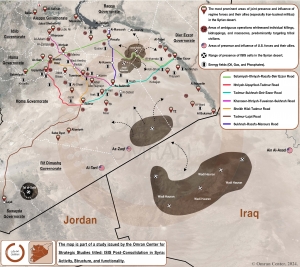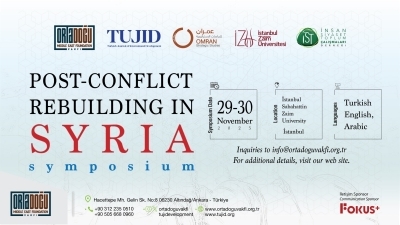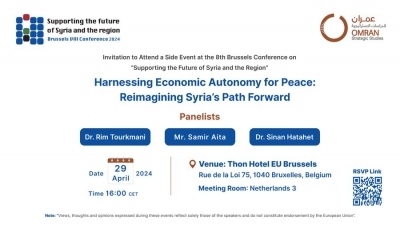Reports
The Syrian Badia: A Map of Influence, Control, and Ambiguous Operations
Following its “defeat” in 2019, the Islamic State (ISIS) adapted in response to both the new scope of its capabilities and the intensified determination of its adversaries. by transitioning from consolidation of power and territorial dominance under a centralized leadership, to a decentralized strategy, relying on autonomous cells and rapid, agile operations. These operations vary in their intensity, patterns, and frequency, depending on the geographic regions and the nature of the forces in control. Operations for which ISIS officially claimed responsibility coincided with other ambiguous operations carried out under its name without an official claim of responsibility. The latter operations targeted both civilian and military individuals and groups through kidnappings and killings.
Although various areas of control have witnessed this type of ambiguous operations, the Syrian desert represented the main stage for it. The period between the 2019 and 2024 saw an increase in operations targeting civilian groups from Arab tribes, especially in the southern desert of Aleppo, which is connected to the desert of Hama, the desert of Homs, as well as the deserts of Al-Rusafa in Al-Raqqa, and Deir Ezzor. Some of these attacks resulted in mass killings that claimed the lives of hundreds of members of tribes in the region, such as Bani Khalid, Al-Amoor, Al-Dulaim, Al-Boshaban, Al-Hadedeen, Al-Gomlan, and Al-Uqaydat tribes. Furthermore, sporadic attacks targeted individuals and groups of shepherds and their livestock, and truffle hunters, rendering the truffle season in the desert deadly.
Several factors contributed to the ambiguity surrounding these operations, notably: the presence of various controlling forces and militias with divergent interests, including ISIS cells that utilized parts of the desert as sanctuaries for launching rapid assaults. The majority of these mass killings transpired on the main highway networks, which is either controlled by Iranian backed militias or is located within areas of their strategic interest, especially in proximity to various energy resources (such as oil, gas, and phosphate) within the region. Moreover, ISIS did not claim responsibility for most of these operations, and their nature differed from what those that ISIS has previously claimed. in terms of tactics and the nature of the targets. Notably, local tribes have accused other forces of being involved in these attacks, particularly the Iranian-backed militias in the region.
The following map highlights the main areas of control in the Syrian desert, as well as key transportation routes, vital energy fields, and areas that have seen ISIS cell activity, and attacks, massacres, and ambiguous operations carried out in ISIS' name between 2019 and 2024.
and to view the map in high resolution: https://bit.ly/44fzTuI
Access the full study (in Arabic) via the Omran Center here: https://bit.ly/3VmhdXC.
The Autonomous Administration: A Judicial Approach to Understanding the Model and Experience
As the central state authority declined, in favor of the emergence of sub-state formations including ethnic and religious ones, along with international and regional interventions, several local governance models have emerged across Syria as reflected by the dynamic military map. This led to the disappearance of some models and the decline of others, whereas other models achieved relative and cautious stability. In this regard, the “Autonomous Administration of North and East Syria” falls within the last category as it developed through several phases until it reached its current model. Although many years have passed since the actual declaration of the Autonomous Administration with its various institutions and bodies, the level of governance and nature of administration in these institutions and bodies remain problematic and questionable. Thus, this study seeks to explore the nature of the administration and the level of governance in this developing model using the judicial authority as an entry point, as it is considered one of the most prominent indicators. The impact of court processes is not limited to the judicial field, nor does it reflect the legal interest alone; it also offers several indicators on the political, administrative, security, economic, and social levels. Therefore, the study examines the judiciary system of the AA, its structure, various institutions, legal foundations, in addition to the employees working in and running those institutions and their qualifications. The study also attempts to explore the effectiveness, efficiency, and working mechanisms of this system, as well as its impact on North-Eastern Syria, in addition to the complex problems in that region (political, tribal, ethnic and “terrorism”).
The Security Landscape in Syria and its Impact on the Return of Refugees An Opinion Survey
- Executive Summary
- The main goal of the study was to inspect factors influencing the return of Syrian refugees from neighboring countries. The study targeted all areas in Syria, including those controlled by the regime, opposition, and the Autonomous Administration (AA). Based on a wide and comprehensive sample, the data was then analyzed to explore the security situation, relations between citizen and state, as well as identify other causes that may be influencing the return of Syrian refugee.
- The study is based upon 620 surveys from Syrian refugees residing in Iraq, Lebanon, Jordan, and Turkey, as well as two Focus-Group Discussions (FGD) in regime-held Dara’a and Damascus Countryside.
- The study is divided into four components; 1) overview of the general security situation, 2) relations between civilians and security apparatuses, 3) factors affecting decision to return, and 4) the experience of refugee return to the particular regions. Each component is based on field research in each of the three uniquely controlled territories in Syria. A number of conclusions were assembled from the sample’s responses to the survey and within the FGDs.
- 1.The General Security Situation – An Overview
- The general security situation in Syria continues to be highly volatile and fragmented mirroring the political, military, and economic instability. To varying degrees, each area is experiencing a host of challenges revolving around the social and economic repercussions from the continued war.
- Based on responses from respondents residing in regime-held areas, the behavior of the security apparatuses affiliated with the Assad regime remains unchanged and persistent in utilizing the same detention and torture tactics as before 2011. The responses highlighted that the Assad-regime has even increased its brutality against civilians.
- The security apparatuses in regime, opposition, and AA held territories are unable to fully control the behavior of individuals, entities, and groups under their respective command at varying degrees. This is mainly due to lack of accountability and corruption.
- Lack of professionalism by security-affiliated officials in opposition-held territories has contributed to the deteriorating security situation.
- In Eastern Syria, within areas under the control of the AA, the security situation varies largely from city to city. While the AA is able to control the Al-Hasaka province, the security situation in Raqqa and Deir Ezzor is deteriorating.
- 2.Relations between Civilians and Security Apparatuses
- The relationship between civilians and security groups in all of Syria are significantly deteriorating. When comparing the three highlighted regions, the security apparatuses in regime-held territories is significantly affecting voluntary return of Syrian refugees from neighboring countries.
- Violations committed by regime security officials has reinforced public resentment, and exacerbated the negative perception of those security regime officials among citizens. The collective resentment and negative perception surrounding the regime’s security apparatuses, makes it difficult for reconciliation to occur in the future, as there is loss of trust and lack of reassurances between the community and the security apparatuses.
- It is apparent that the Assad regime’s security mechanism is no longer able to control the different military factions and militias. The inability to control armed groups has further ignited public wrath.
- In opposition-held areas, security groups are facing challenges in minimizing the influence of differing factions and in curbing their violations against civilians. Many of these factions refuse to abide by set rules.
- In all areas, citizens have little confidence that security apparatuses would address their complaints and believe they are biased in terms of arrests and complaint management.
- After 2011, regime security apparatuses relied increasingly on internal and external espionage networks by recruiting informants in all areas, across social classes and in countries hosting Syrian refugees. It is important to note that the Assad regime closely monitors returnees in areas in which the regime regained control.
- 3.Factors Affecting the Decision to Return
- With the deteriorating economic situation in Syria, access to a sustainable livelihood is among the most important factor considered by returnees. Other important factors that influence the decision to return included securing their property rights, accessing public services, and the prevalence of social and moral corruption.
- Seeking a voluntary and dignified return, Syrian participants highlighted the need for a UN-sponsored system that guarantees their security and safety upon return. Other push factors include: the level of services and living conditions, personal security, protection from discriminations, and legal/social stability experienced in host countries. All of these are significant factors that would influence their return.
- Most Syrian refugees attain information on the local situation through relatives and friends inside Syria, and is listed as their most relied upon source. This is followed by information from social media, international media outlets, and non-regime affiliated media outlets, as well as reports issued by civil society organizations or international organizations.
- The threat of facing arbitrary arrest by the Assad regime security, militias, and military factions was the most listed reason for delayed return among displaced Syrians. Fear of detention by the regime or other armed forces in Syria is followed by theft, abduction, and blackmailing for ransom. Other important considerations included local and foreign militias, the prevalence of assassinations, and random blasts.
- Displaced Syrians most at risk of arrest upon return to Assad regime-held areas are political activists, members of the Free Syrian Army, and members of opposition-military factions, defectors from the regime military, and those targeted for military conscription. This is followed by employees who defected from regime institutions, individuals from anti-regime areas, and businessmen respectively.
- 4.Refugee Return to Regions under various control
- For a large percentage of refugees, return to regime-held territories is difficult without international guarantees of safety. Even if refugees are able to return, services are selectively distributed based on regional demographics, Additionally, the regime’s security apparatuses would need to be reformed, which is close to impossible without structural changes in the country’s governance systems. The security apparatuses are closely linked to the Assad regime, which refuses any reforms or restructuring.
- Opposition-held territories are fragile and suffer from security infiltrations. The instability and lack of security largely affects the lives of civilians, as they live in fear of further situational decline. Absent of a comprehensive strategy and logistical capacity, the security forces in opposition-held territory are unable to guarantee safety and stability for civilians. The security situation within these areas is likely to continue deteriorating with the Assad regime’s agenda to advance and displacing more Syrians.
- AA-held territories suffering from pro-longed bureaucracies within the security apparatuses and wide-spread discriminatory practices including arbitrary arrest and protest suppression. This prevented a sense of stability within the AA regions. The lack of trust between communities and the AA’s security apparatuses reflects the instability of the areas. Additionally, there remain ISIS sleeper cells also contributing to security instability. These contributing factors prevent refugees from returning to their homes in AA territories.
- Introduction
Entering its tenth year, the Syrian conflict has resulted in a host of challenges for Syrian refugees in neighboring countries. The topic of return is among the most critical in local and international conversations, which remains a challenge with no solution in sight. Without a conducive political, social, and economically environment, voluntary return will be limited. A number of items must be considered to elevate the option of voluntary return, including securing a safe and dignified return, maintaining regional stability, and arranging the appropriate regional and international circumstances to ensure the availability of the objective conditions necessary for such return.
When discussing the internal factors in which effect the return of Syria’s displaced, the security situation is the most mentioned. The security conditions in all areas of Syria significantly influence an individual’s decision to return. With deteriorating security conditions, civilians are unable to feel safe and stable. With fear of being displaced again due to security reasons, they are deterred from voluntary return. With the ongoing crisis, maintaining a secure space remains difficult for security forces in opposition, Assad regime, and Autonomous Administration (AA) held territory. The path towards providing civilians with a sense of safety and stability there must be a political and military solution. Recovery and reconstruction may only begin when a safe environment is secured.
Omran Centre for Strategic Studies implemented a survey targeting individuals from regime, opposition, and AA-held territories. This survey is integral as it illustrates the perspective of civilians concerning the security situation and factors influencing their return. From the surveys, it is apparent that locally civilians understand the security conditions intensively, and are aware. The chaotic security situation -is manifested in a host of violations that come in different forms, tools, and intensities. Thus, it reflects the fragility and volatility of the security environment, which is inconsistent with the demand that international bodies seek to fulfil as one of the objective prerequisites for the safe and voluntary return of Syrian refugees from neighboring countries.
The goal of the survey was to identify primary and secondary factors as well as indicators related to the primary indicator of security stability in Syria. These secondary indicators include the efficiency of security apparatuses as well as the legal system associated with them, the performance of these apparatuses and their security operations in addition to relevant accountability, follow-up and complaints systems, as well as the extent to which these indicators have an impact on the return of the Syrian refugees from neighboring countries. First, the survey attempts to diagnose the general security landscape in various Syrian regions, then to identify the nature of relationships between civilians and security apparatuses in these areas, furthermore identifying the most important variables that govern the refugees' decision to return to Syria. Finally, it examines the reality of the refugees' return to Assad regime-held areas, opposition-held areas, and AA areas to determine the most important indicators related to the return of refugees to these areas.
For More Click Here: https://bit.ly/3gReLSU
Navvar Saban talking about Deadly IS attacks in Syria
Navvar Saban (Oliver), a military analyst at Omran Center, gave a statement to AFP about Regime and allies claiming that ISIS has been completely defeated, and why it’s inaccurate. Saban discusses the misconception of conflating ISIS' loss of control of urban territory with the groups overall demise. Although places like Raqqa and Deir Ezzor have been ridden of ISIS, the group has relocated into desert areas where it now launches hit-and-run raids on regime and allies locations.
According to Saban , "These attacks will continue, targeting pipelines, main roads, border crossings -- which will give any government a huge headache."
The resource: https://yhoo.it/2sQdPGn
Mapping the Battle Against ISIS in Deir Ezzor
In recent weeks, the so-called Islamic State has suffered a string of defeats in eastern Syria. It has lost swaths of territory in Deir Ezzor city to advancing pro-Syrian government forces and has been driven from villages and oil fields on the eastern banks of the Euphrates River by a U.S.-backed paramilitary group.
The two simultaneous but separate offensives by the Syrian Democratic Forces (SDF) and Syrian government loyalists may have resulted in quick gains in their first few weeks, but fighting is ongoing in many parts of the province, much of which remains under complete militant control.
ISIS still controls roughly 74 percent of the Deir Ezzor province and commands two main strongholds in the areas of Boukamal and Mayadin, south of the provincial capital. The group also controls a resource-rich region east of the Euphrates River that contains most of the oil and gas fields in the province.
With a long and grueling campaign still underway to expel the militant group from its last bastion in Syria, Syria Deeply examines the battle for Deir Ezzor by looking at the main groups, their objectives and their advances in the region.
Who Is Fighting in Deir Ezzor
Syrian government loyalists are the main fighting force in Deir Ezzor city and the surrounding countryside. Their forces consist of two specialized Syrian army divisions: the Republican Guard and the 17th Reserve Division, which is responsible for northern and eastern Syria.
A number of pro-government militias are assisting, including the Baath Battalions, a Syrian paramilitary group that fought rebels in Aleppo province last year. The Galilee Forces (a Palestinian militia), the National Defense Forces(one of the largest pro-government militias operating in Syria), and the Syrian al-Qassam group’s elite forces.
The Lebanese Hezbollah and a number of other Iran-backed groups are also fighting alongside the Syrian army in Deir Ezzor, as are a number of local tribes, most notably the al-Shaitat tribe. Russian warplanes are providing aerial cover for pro-government advances, and Moscow announced on Thursday that it has deployed special forces to assist the Syrian army.
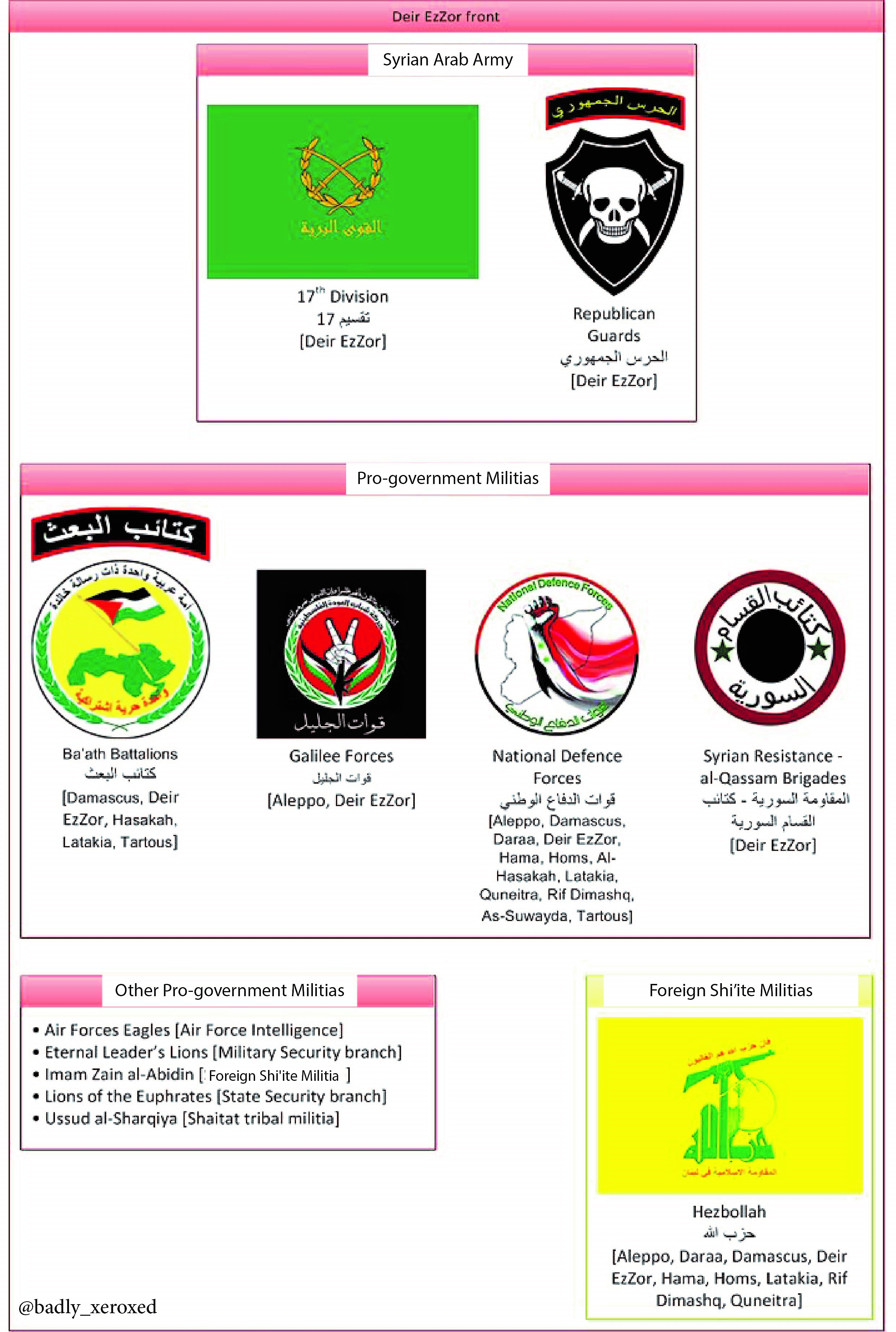
Infographic breaking down the multiple groups fighting alongside the Syrian army in Deir Ezzor. (Nawar Oliver)
On the eastern banks of the Euphrates River, a contingent of the U.S.-backed Syrian Democratic Forces, known as the Deir Ezzor military council, is also fighting ISIS. It is supported by U.S.-led coalition warplanes and U.S. special forces embedded within its ranks. The Deir Ezzor military council is made up mostly of Arab fighters from Deir Ezzor, but is supported by Kurdish fighters of the SDF.
The Race for Deir Ezzor
Although the SDF and the Syrian government have framed their respective operations in Deir Ezzor as primarily a battle against ISIS, each side has other objectives.
For the Syrian government, recapturing Deir Ezzor has been a main priority since the start of 2017, and gaining complete control over Deir Ezzor city, the largest city in eastern Syria, would be a symbolic victory.
Control over the oil-rich region on the southeastern flanks of Deir Ezzor province would also secure key natural resource revenues for the Syrian government.
The province is located along part of Syria’s border with Iraq, so controlling the area would help the government reassert its authority over the quasi-totality of its frontier with its southeastern neighbor. Increased government influence in Deir Ezzor would also help Iran secure a land bridge between Iraq and Syria, especially via the city of Mayadin, which provides a land route from Damascus to Iraq.
The government’s push in Deir Ezzor is also aimed at preventing a Raqqa scenario. In other words, the Syrian government is trying to keep U.S.-backed forces in Syria from carving out a zone of influence in the eastern province after ISIS withdraws.
For the SDF and its primary backer, Washington, the battle for Deir Ezzor is largely posturing against Assad’s forces. The group announced its operation in Deir Ezzor only days after pro-government forces breached ISIS’ siege on parts of the city, signaling to the government that its advance in the province would not go uncontested.
Although the SDF has said it would not enter Deir Ezzor city and would leave the area to pro-government forces, the group is seeking to expand its influence in the oil-rich parts of the province on the eastern banks of the Euphrates and in ISIS strongholds near the border with Iraq. This push is driven by Washington’s aim to secure the Iraqi border and prevent Iran from gaining a foothold in the region.
Tracing Government Advances
In recent weeks, pro-government forces have pushed into Deir Ezzor city from the west, along the al-Sukhna-Deir Ezzor highway, and achieved significant territorial victories in the provincial capital and its countryside. They have pushed ISIS militants back from areas around a military garrison known as Brigade 137, have breached a three-year siege of Deir Ezzor’s military airbase and a number of adjacent neighborhoods, and have also secured the strategic Deir Ezzor-Damascus highway.
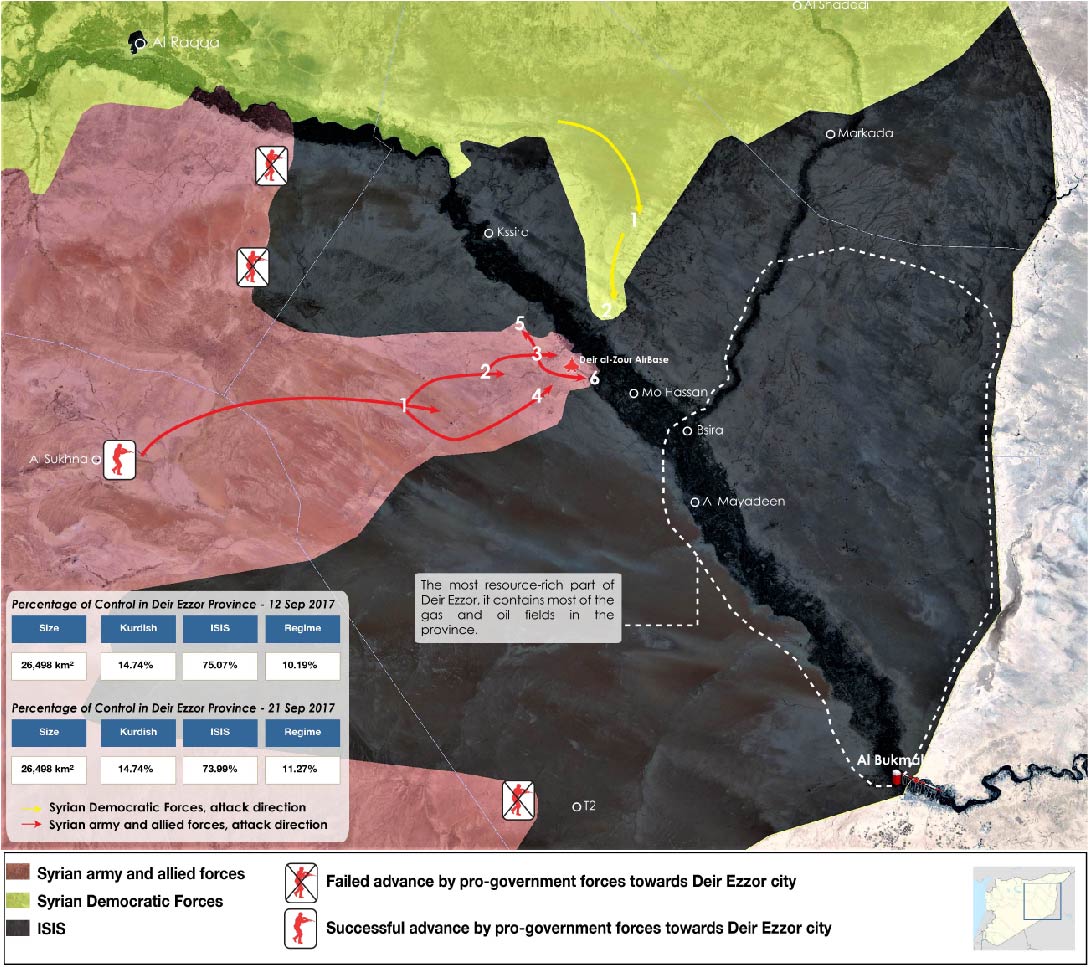
Map of control for Deir Ezzor province that also shows advances by pro-government forces and the SDF. (Nawar Oliver)
The Syrian army said over the weekend that its forces have captured at least 44 villages and towns since launching the assault on Deir Ezzor earlier this month. According to the Syria Observatory for Human Rights (SOHR), pro-government forces control roughly 64.3 percent of the provincial capital, while ISIS militants control 35.7 percent. Russia’s Defense Ministry, however, said last week that pro-government forces are in control of at least 85 percent.
They have also made significant gains on the western banks of the Euphrates, in Deir Ezzor’s northwestern countryside, where they have captured more than 60 miles (100km) of former ISIS territory, the SOHR said last week.
Pro-government forces also crossed into the eastern bank of the Euphrates last week, reaching within 3 miles (5km) of SDF-held positions.
The government’s advance suggests three short-term objectives. By expanding control on the western and eastern banks of the Euphrates, the Syrian government is trying to seal the eastern and western gateways to the city, thereby besieging ISIS in a pocket in the provincial capital.
It is also trying to complicate SDF advances in the region by preventing the group from reaching ISIS positions on the western axis while also blocking any potential SDF push down the east bank of the Euphrates.
The advance on the eastern banks of the Euphrates is also driven by an attempt to secure oil and gas fields in the area, most notably the al-Omar oil field, Syria’s largest and most lucrative field.
Current advances, however, do not signal an imminent push south toward ISIS strongholds in Boukamal and Mayadin. It would appear then that the real battle in ISIS’ best-fortified stronghold is delayed.
Tracing SDF Advances
Over the past two weeks, the SDF has pushed into Deir Ezzor province from the northeast using the Hassakeh-Deir Ezzor Highway, gaining full control of Deir Ezzor’s industrial zone and capturing a major gas field in the area.
The Conoco gas plant, Syria’s largest, came under full SDF control on Saturday, after days of fighting ISIS militants in the area. The plant had the largest capacity of any in Syria prior to the conflict, producing up to 459 million cubic feet (13 million cubic meters) of natural gas a day.
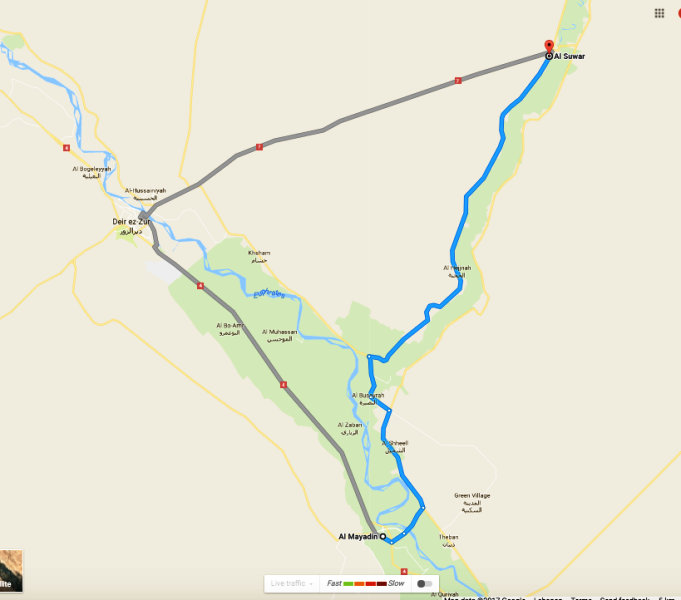
SDF forces are now moving away from Deir Ezzor city and advancing toward the Iraqi border. On Sunday, the push to capture the town of al-Suwar began, according to the SOHR. The area is a strategic junction which provides land and supply routes connecting SDF positions to ISIS strongholds in Boukamal and Mayadin. A coalition spokesman said over the weekend that these two ISIS strongholds, some 50 miles (80km) west of the Iraqi border, are the SDF’s eventual goal.
Risk of Confrontation
The race for gas and oil fields in the eastern banks of the Euphrates has increased tensions between Russia, the U.S. and their respective allies over resource-rich parts of Deir Ezzor.
The SDF said on Monday that Russian warplanes bombed their positions in the Conoco gas field, killing one SDF fighter and wounding two others, just two days after the U.S.-backed forces captured the area.
That same day Moscow blamed U.S. policy in Syria for the death of Russian Lt. Gen. Valery Asapov in ISIS shelling near Deir Ezzor one day earlier.
“The death of the Russian commander is the price, the bloody price, for two-faced American policy in Syria,” Russian deputy foreign minister Sergei Ryabkov said. “The American side declares that it is interested in the elimination of [ISIS] … but some of its actions show it is doing the opposite and that some political and geopolitical goals are more important for Washington.”
This is not the first time that the two sides have traded jabs over attacks in east Syria. Earlier this month, the SDF and the Pentagon accused Russia of shelling an SDF position in Deir Ezzor’s industrial zone. Last week, Russia said that it would target SDF positions in east Syria if pro-government forces come under fire from the group.
Moscow’s warning came after Russia accused the SDF of opening fire on Syrian troops and allied forces on the eastern bank of the Euphrates twice last week. Moscow has also accused the SDF of hindering government advances in the area by opening upstream dams to prevent its allies from crossing.
In an attempt to prevent an outbreak of clashes, U.S. and Russian generals held a face-to-face meeting to discuss operations in Deir Ezzor last week.
“The discussions emphasized the need to share operational graphics and locations to ensure … prevention of accidental targeting or other possible frictions that would distract from the defeat of ISIS,” Col. Ryan Dillon said.
Monday’s attack undermines earlier talks and signals that the U.S. and Russia have yet to reach an agreement over the oil-rich zone coveted by all sides. With Monday’s attacks, it would seem that oil-rich areas east of the Euphrates will serve as a testing ground for U.S. and Russian de-confliction arrangements.
If the two sides fail to delineate areas of respective control then sporadic fighting will continue to obstruct the campaign against ISIS in the area and will leave both sides vulnerable to militant counterattacks.
Published In The Syria Deeply, 26 Sep. 2017,
Written byHashem Osseiran, Nawar Oliver

